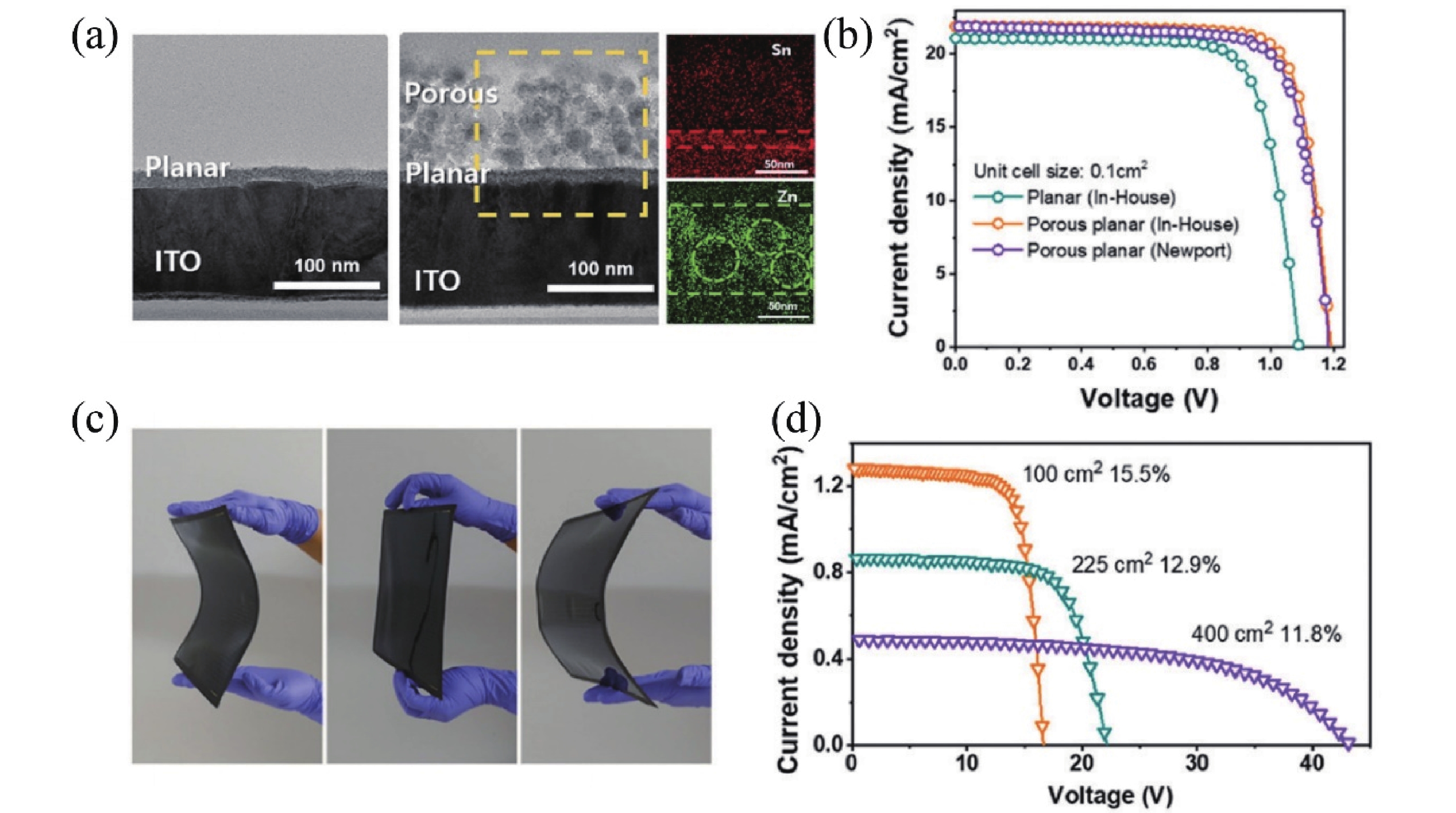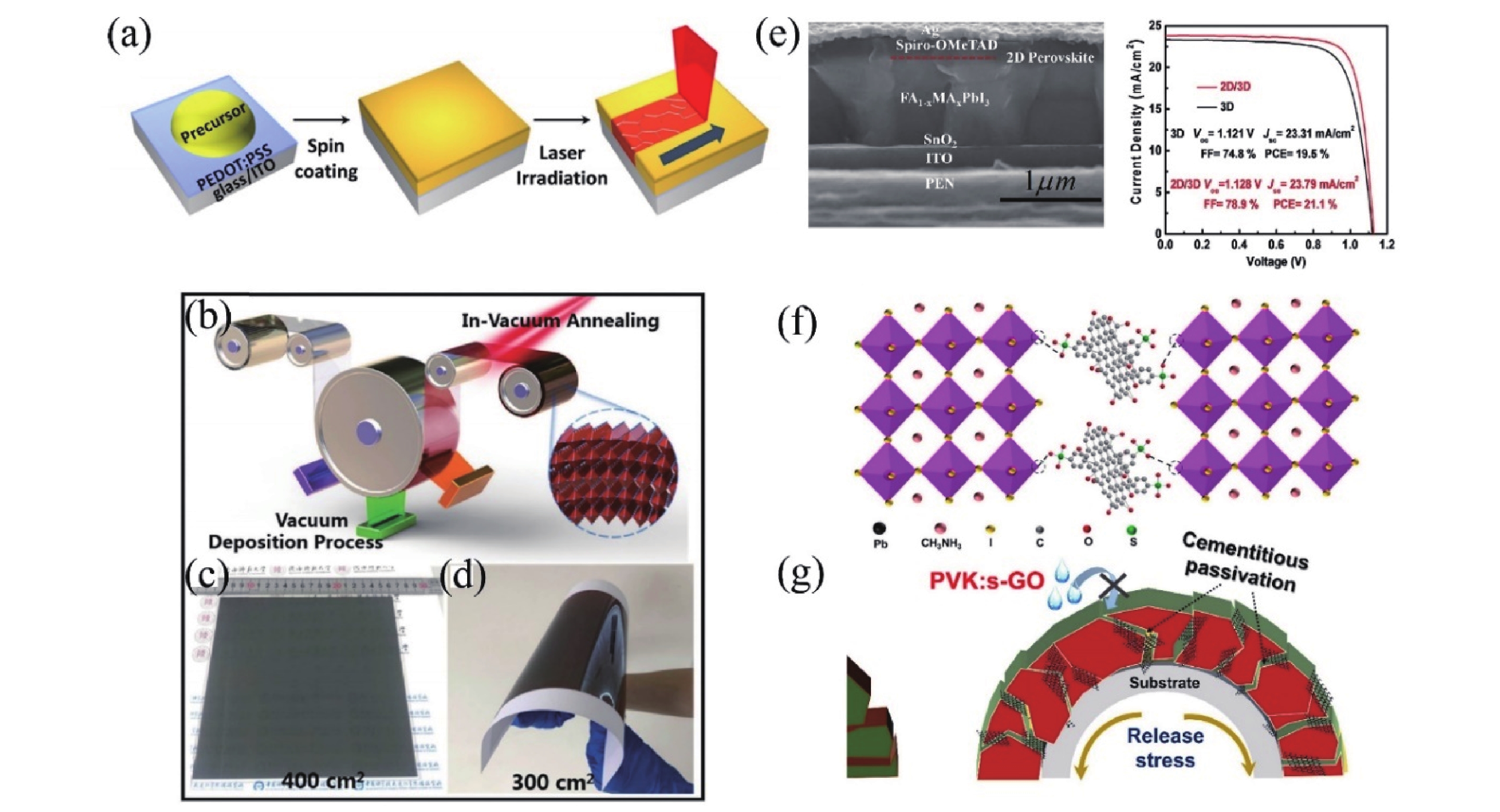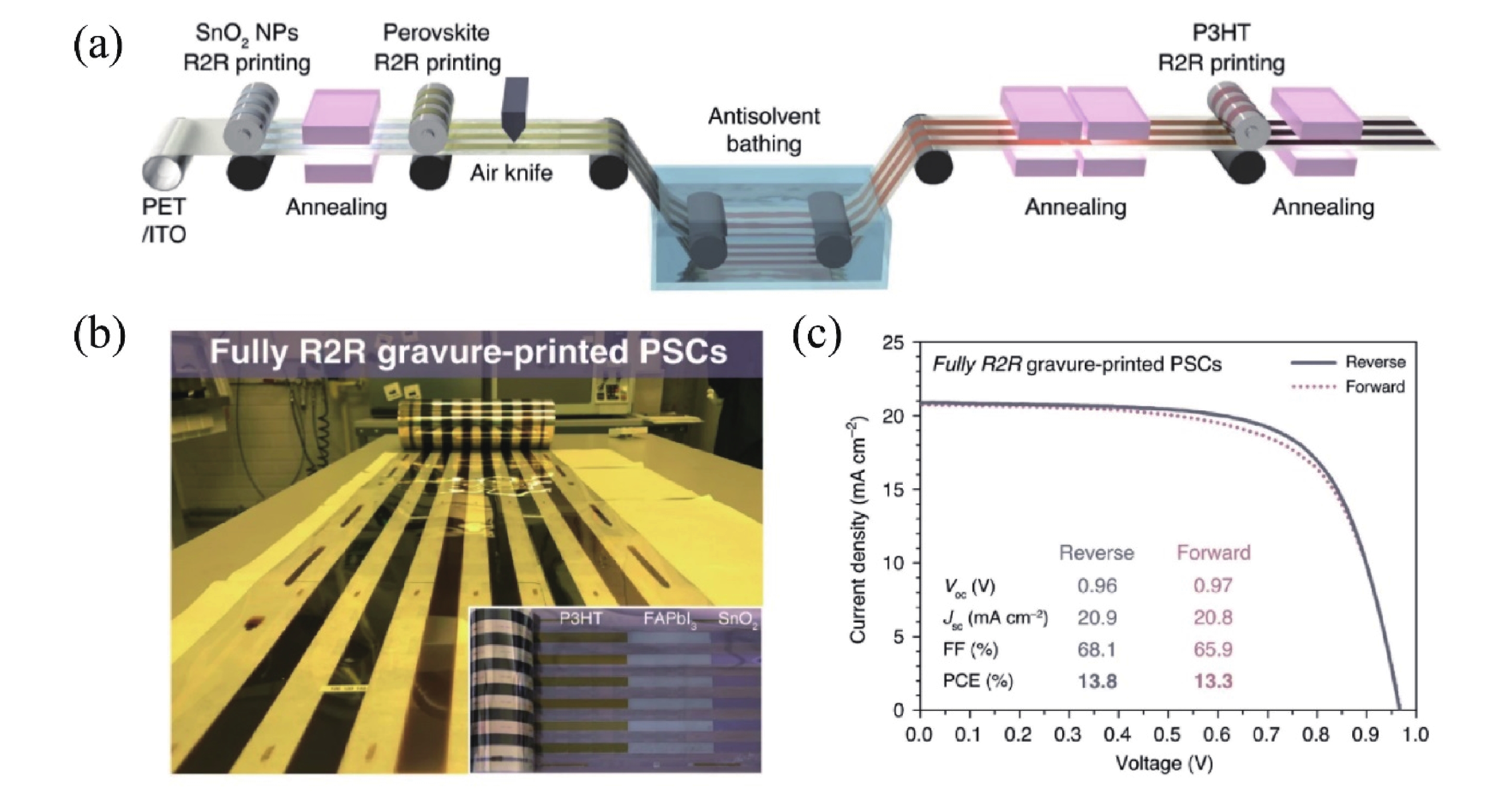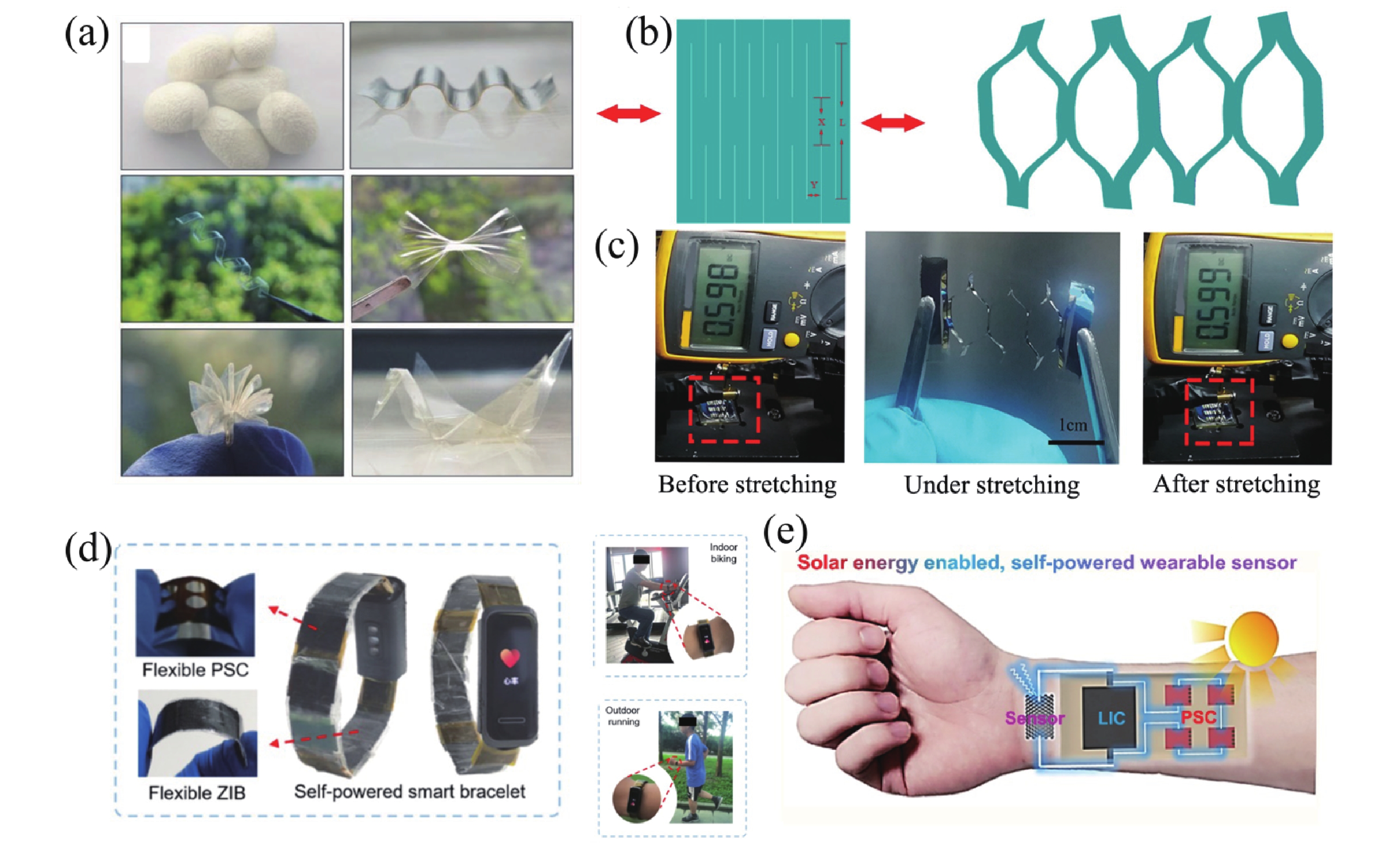| Citation: |
Guanqi Tang, Feng Yan. Flexible perovskite solar cells: Materials and devices[J]. Journal of Semiconductors, 2021, 42(10): 101606. doi: 10.1088/1674-4926/42/10/101606
****
G Q Tang, F Yan, Flexible perovskite solar cells: Materials and devices[J]. J. Semicond., 2021, 42(10): 101606. doi: 10.1088/1674-4926/42/10/101606.
|
Flexible perovskite solar cells: Materials and devices
DOI: 10.1088/1674-4926/42/10/101606
More Information
-
Abstract
Flexible perovskite solar cells (FPSCs) are supposed to play an important role in the commercialization of perovskite solar cells due to their unique properties, such as high efficiency, thin thickness and being compatible with roll to roll (R2R) process for mass production. At present, deformable and lightweight FPSCs have been successfully prepared and applied as power supply by integrating with different wearable and portable electronics, which opens a niche market for photovoltaics. In this mini review, we will introduce the recent progress of FPSCs from the aspect of small-area flexible devices, R2R processed devices with large scale and emerging flexible cells with deformability and stretchability. Finally, conclusion and outlook are provided. -
References
[1] Kojima A, Teshima K, Shirai Y, et al. Organometal halide perovskites as visible-light sensitizers for photovoltaic cells. J Am Chem Soc, 2009, 131, 6050 doi: 10.1021/ja809598r[2] Kim H S, Lee C R, Im J H, et al. Lead iodide perovskite sensitized all-solid-state submicron thin film mesoscopic solar cell with efficiency exceeding 9%. Sci Rep, 2012, 2, 591 doi: 10.1038/srep00591[3] Green M A, Baillie A H, Snaith H S. The emergence of perovskite solar cells. Nat Photon, 2014, 8, 506 doi: 10.1038/nphoton.2014.134[4] Tan H, Jain A, Voznyy O, et al. Efficient and stable solution-processed planar perovskite solar cells via contact passivation. Science, 2017, 355, 722 doi: 10.1126/science.aai9081[5] Hui W, Chao L, Lu H, et al. Stabilizing black-phase formamidinium perovskite formation at room temperature and high humidity. Science, 2021, 371, 1359 doi: 10.1126/science.abf7652[6] Bu T, Li J, Li H, et al. Lead halide–templated crystallization of methylamine-free perovskite for efficient photovoltaic modules. Science, 2021, 372, 1327 doi: 10.1126/science.abh1035[7] Xue J, Wang R, Chen X, et al. Reconfiguring the band-edge states of photovoltaic perovskites by conjugated organic cations. Science, 2021, 371, 636 doi: 10.1126/science.abd4860[8] Lu H, Liu Y, Ahlawat P, et al. Vapor-assisted deposition of highly efficient, stable black-phase FAPbI3 perovskite solar cells. Science, 2020, 370, eabb8985 doi: 10.1126/science.abb8985[9] Tai Q D, You P, Sang H, et al. Efficient and stable perovskite solar cells prepared in ambient air irrespective of the humidity. Nat Commun, 2016, 7, 11105 doi: 10.1038/ncomms11105[10] Tang G Q, You P, Tai Q D, et al. Solution-phase epitaxial growth of perovskite films on 2D material flakes for high-performance solar cells. Adv Mater, 2019, 31, 1807689 doi: 10.1002/adma.201807689[11] You P, Tang G Q, Cao J P, et al. 2D materials for conducting holes from grain boundaries in perovskite solar cells. Light Sci Appl, 2021, 10, 68 doi: 10.1038/s41377-021-00515-8[12] Feng J. Mechanical properties of hybrid organic-inorganic CH3NH3BX3 (B = Sn, Pb; X = Br, I) perovskites for solar cell absorbers. APL Mater, 2014, 2, 081801 doi: 10.1063/1.4885256[13] Rong Y G, Hu Y, Mei A Y, et al. Challenges for commercializing perovskite solar cells. Science, 2018, 361, eaat8235 doi: 10.1126/science.aat8235[14] Park N G, Grätzel M, Miyasaka T, et al. Towards stable and commercially available perovskite solar cells. Nat Energy, 2016, 1, 16152 doi: 10.1038/nenergy.2016.152[15] Park S, Heo S W, Lee W, et al. Self-powered ultra-flexible electronics via nano-grating-patterned organic photovoltaics. Nature, 2018, 561, 516 doi: 10.1038/s41586-018-0536-x[16] Kaltenbrunner M, Adam G, Głowacki E D, et al. Flexible high power-per-weight perovskite solar cells with chromium oxide –metal contacts for improved stability in air. Nat Mater, 2015, 14, 1032 doi: 10.1038/nmat4388[17] Zhao J Q, Xu Z J, Zhou Z, et al. A safe flexible self-powered wristband system by integrating defective MnO2–x nanosheet-based zinc-ion batteries with perovskite solar cells. ACS Nano, 2021, 15, 10597 doi: 10.1021/acsnano.1c03341[18] Kumar M H, Yantara N, Dharani S, et al. Flexible, low-temperature, solution processed ZnO-based perovskite solid state solar cells. Chem Commun, 2013, 49, 11089 doi: 10.1039/c3cc46534a[19] Yang L K, Xiong Q, Li Y B, et al. Artemisinin-passivated mixed-cation perovskite films for durable flexible perovskite solar cells with over 21% efficiency. J Mater Chem A, 2021, 9, 1574 doi: 10.1039/D0TA10717D[20] Long C Y, Huang K Q, Chang J H, et al. Creating a dual-functional 2D perovskite layer at the interface to enhance the performance of flexible perovskite solar cells. Small, 2021, 2102368 doi: 10.1002/smll.202102368[21] Lee G, Kim M C, Choi Y W, et al. Ultra-flexible perovskite solar cells with crumpling durability: toward a wearable power source. Energy Environ Sci, 2019, 12, 3182 doi: 10.1039/C9EE01944H[22] Park N G, Zhu K. Scalable fabrication and coating methods for perovskite solar cells and solar modules. Nat Rev Mater, 2020, 5, 333 doi: 10.1038/s41578-019-0176-2[23] Wang H, Huang Z, Xiao S, et al. An in situ bifacial passivation strategy for flexible perovskite solar module with mechanical robustness by roll-to-roll fabrication. J Mater Chem A, 2021, 9, 5759 doi: 10.1039/D0TA12067G[24] Kim Y Y, Yang T Y, Suhonen R, et al. Roll-to-roll gravure-printed flexible perovskite solar cells using eco-friendly antisolvent bathing with wide processing window. Nat Commun, 2020, 11, 5146 doi: 10.1038/s41467-020-18940-5[25] Li C, Cong S, Tian Z, et al. Flexible perovskite solar cell-driven photo-rechargeable lithium-ion capacitor for self-powered wearable strain sensors. Nano Energy, 2019, 60, 247 doi: 10.1016/j.nanoen.2019.03.061[26] Qiu L, Deng J, Lu X, et al. Integrating perovskite solar cells into a flexible fiber. Angew Chem Int Ed, 2014, 53, 10425 doi: 10.1002/anie.201404973[27] Zardetto V, Brown T M, Reale A, et al. Substrates for flexible electronics: A practical investigation on the electrical, film flexibility, optical, temperature, and solvent resistance properties. J Polym Sci Polym Phys, 2011, 49, 638 doi: 10.1002/polb.22227[28] Weerasinghe H C, Dkhissi Y, Scully A D, et al. Encapsulation for improving the lifetime of flexible perovskite solar cells. Nano Energy, 2015, 18, 118 doi: 10.1016/j.nanoen.2015.10.006[29] Cho E, Kim Y Y, Ham D S, et al. Highly efficient and stable flexible perovskite solar cells enabled by using plasma-polymerized-fluorocarbon antireflection layer. Nano Energy, 2021, 82, 105737 doi: 10.1016/j.nanoen.2020.105737[30] Yoon J, Kim U, Choi J S, et al. Bioinspired liquid-repelling sealing films for flexible perovskite solar cells. Mater Today Energy, 2021, 20, 100622 doi: 10.1016/j.mtener.2020.100622[31] Abdollahi Nejand B, Nazari P, Gharibzadeh S, et al. All-inorganic large-area low-cost and durable flexible perovskite solar cells using copper foil as a substrate. Chem Commun, 2017, 53, 747 doi: 10.1039/C6CC07573H[32] Han G S, Lee S, Duff M L, et al. Highly bendable flexible perovskite solar cells on a nanoscale surface oxide layer of titanium metal plates. ACS Appl Mater Interfaces, 2018, 10, 4697 doi: 10.1021/acsami.7b16499[33] Lee M, Jo Y, Kim D S, et al. Efficient, durable and flexible perovskite photovoltaic devices with Ag-embedded ITO as the top electrode on a metal substrate. J Mater Chem A, 2015, 3, 14592 doi: 10.1039/C5TA03240G[34] Troughton J, Bryant D, Wojciechowski K, et al. Highly efficient, flexible, indium-free perovskite solar cells employing metallic substrates. J Mater Chem A, 2015, 3, 9141 doi: 10.1039/C5TA01755F[35] Lee M, Jo Y, Kim D S, et al. Flexible organo-metal halide perovskite solar cells on a Ti metal substrate. J Mater Chem A, 2015, 3, 4129 doi: 10.1039/C4TA06011C[36] Heo J H, Shin D H, Lee L M, et al. Efficient organic–inorganic hybrid flexible perovskite solar cells prepared by lamination of polytriarylamine/CH3NH3PbI3/anodized Ti metal substrate and graphene/PDMS transparent electrode substrate. ACS Appl Mater Interfaces, 2018, 10, 31413 doi: 10.1021/acsami.8b11411[37] Dou B, Miller E M, Christians J A, et al. High-performance flexible perovskite solar cells on ultrathin glass: implications of the TCO. J Phys Chem Lett, 2017, 8, 4960 doi: 10.1021/acs.jpclett.7b02128[38] Tavakoli M M, Tsui K H, Zhang Q, et al. Highly efficient flexible perovskite solar cells with antireflection and self-cleaning nanostructures. ACS Nano, 2015, 9, 10287 doi: 10.1021/acsnano.5b04284[39] Dai X, Deng Y, Van Brackle C H, et al. Scalable fabrication of efficient perovskite solar modules on flexible glass substrates. Adv Energy Mater, 2020, 10, 1903108 doi: 10.1002/aenm.201903108[40] Ahn J, Hwang H, Jeong S, et al. Metal-nanowire-electrode-based perovskite solar cells: challenging issues and new opportunities. Adv Energy Mater, 2017, 7, 1602751 doi: 10.1002/aenm.201602751[41] Kang S, Jeong J, Cho S, et al. Ultrathin, lightweight and flexible perovskite solar cells with an excellent power-per-weight performance. J Mater Chem A, 2019, 7, 1107 doi: 10.1039/C8TA10585E[42] Sears K K, Fievez M, Gao M, et al. ITO-free flexible perovskite solar cells based on roll-to-roll, slot-die coated silver nanowire electrodes. Sol RRL, 2017, 1, 1700059 doi: 10.1002/solr.201700059[43] Li Y, Meng L, Yang Y, et al. High-efficiency robust perovskite solar cells on ultrathin flexible substrates. Nat Commun, 2016, 7, 10214 doi: 10.1038/ncomms10214[44] Li P, Wu Z, Hu H, et al. Efficient flexible perovskite solar cells using low-cost cu top and bottom electrodes. ACS Appl Mater Interfaces, 2020, 12(23), 26050 doi: 10.1021/acsami.0c06461[45] Li M, Zuo W W, Ricciardulli A G, et al. Embedded nickel-mesh transparent electrodes for highly efficient and mechanically stable flexible perovskite photovoltaics: toward a portable mobile energy source. Adv Mater, 2020, 32, 2003422 doi: 10.1002/adma.202003422[46] Liu Z K, You P, Xie C, et al. Ultrathin and flexible perovskite solar cells with graphene transparent electrodes. Nano Energy, 2016, 28, 151 doi: 10.1016/j.nanoen.2016.08.038[47] Zhang J, Hu X G, Li H, et al. High-performance ITO-free perovskite solar cells enabled by single-walled carbon nanotube films. Adv Funct Maters, 2021, 31, 2104396 doi: 10.1002/adfm.202104396[48] Lu H, Sun J, Zhang H, et al. Room-temperature solution-processed and metal oxide-free nano-composite for the flexible transparent bottom electrode of perovskite solar cells. Nanoscale, 2016, 8, 5946 doi: 10.1039/C6NR00011H[49] Jeong G, Koo D, Seo J, et al. Suppressed interdiffusion and degradation in flexible and transparent metal electrode-based perovskite solar cells with a graphene interlayer. Nano Lett, 2020, 20, 3718 doi: 10.1021/acs.nanolett.0c00663[50] Yang H, Kwon H C, Ma S, et al. Energy level-graded Al-doped ZnO protection layers for copper nanowire-based window electrodes for efficient flexible perovskite solar cells. ACS Appl Mater Interfaces, 2020, 12, 13824 doi: 10.1021/acsami.9b21290[51] Yoon J, Sung H, Lee G, et al. Superflexible, high-efficiency perovskite solar cells utilizing graphene electrodes: towards future foldable power sources. Energy Environ Sci, 2017, 10, 337 doi: 10.1039/C6EE02650H[52] Jeon I, Chiba T, Delacou C, et al. Single-walled carbon nanotube film as electrode in indium-free planar heterojunction perovskite solar cells: investigation of electron-blocking layers and dopants. Nano Lett, 2015, 15, 6665 doi: 10.1021/acs.nanolett.5b02490[53] Peng C, Su H, Li J, et al. Scalable, efficient and flexible perovskite solar cells with carbon film based electrode. Sol Energy Mater Sol Cells, 2021, 230, 111226 doi: 10.1016/j.solmat.2021.111226[54] Jin J, Li J H, Tai Q D, et al. Efficient and stable flexible perovskite solar cells based on graphene-AgNWs substrate and carbon electrode without hole transport materials. J Power Sources, 2021, 482, 228953 doi: 10.1016/j.jpowsour.2020.228953[55] Jeon I, Yoon J, Ahn N, et al. Carbon nanotubes versus graphene as flexible transparent electrodes in inverted perovskite solar cells. J Phys Chem Lett, 2017, 8, 5395 doi: 10.1021/acs.jpclett.7b02229[56] Worfolk B J, Andrews S C, Park S, et al. Ultrahigh electrical conductivity in solution-sheared polymeric transparent films. Proc Natl Acad Sci, 2015, 112, 14138 doi: 10.1073/pnas.1509958112[57] Fan X, Nie W, Tsai H, et al. PEDOT:PSS for flexible and stretchable electronics: modifications, strategies, and applications. Adv Sci, 2019, 6, 1900813 doi: 10.1002/advs.201900813[58] Hu C, Meng X, Zhang L, et al. A mechanically robust conducting polymer network electrode for efficient flexible perovskite solar cells. Joule, 2019, 3, 2205 doi: 10.1016/j.joule.2019.06.011[59] Jeon N J, Na H, Jung E H, et al. A fluorene-terminated hole-transporting material for highly efficient and stable perovskite solar cells. Nat Energy, 2018, 3, 682 doi: 10.1038/s41560-018-0200-6[60] Chung J, Shin S S, Hwang K, et al. Record-efficiency flexible perovskite solar cell and module enabled by a porous-planar structure as an electron transport layer. Energy Environ Sci, 2020, 13, 4854 doi: 10.1039/D0EE02164D[61] Heo J H, Lee M H, Han H J, et al. Highly efficient low temperature solution processable planar type CH3NH3PbI3 perovskite flexible solar cells. J Mater Chem A, 2016, 4, 1572 doi: 10.1039/C5TA09520D[62] Yang D, Yang R, Zhang J, et al. High efficiency flexible perovskite solar cells using superior low temperature TiO2. Energy Environ Sci, 2015, 8, 3208 doi: 10.1039/C5EE02155C[63] Huang K, Peng Y, Gao Y, et al. High-performance flexible perovskite solar cells via precise control of electron transport layer. Adv Energy Mater, 2019, 9, 1901419 doi: 10.1002/aenm.201901419[64] Park S Y, Baek M Y, Ju Y, et al. Simultaneous ligand exchange fabrication of flexible perovskite solar cells using newly synthesized uniform tin oxide quantum dots. J Physl Chem Lett, 2018, 9, 5460 doi: 10.1021/acs.jpclett.8b02408[65] Yang D, Yang R, Wang K, et al. High efficiency planar-type perovskite solar cells with negligible hysteresis using EDTA-complexed SnO2. Nat Commun, 2018, 9, 3239 doi: 10.1038/s41467-018-05760-x[66] Shin S S, Yang W S, Yeom E J, et al. Tailoring of electron-collecting oxide nanoparticulate layer for flexible perovskite solar cells. J Phys Chem Lett, 2016, 7, 1845 doi: 10.1021/acs.jpclett.6b00295[67] Liu D, Kelly T L. Perovskite solar cells with a planar heterojunction structure prepared using room-temperature solution processing techniques. Nat Photonics, 2014, 8, 133 doi: 10.1038/nphoton.2013.342[68] Zhao X, Tian L, Liu T, et al. Room-temperature-processed fullerene single-crystalline nanoparticles for high-performance flexible perovskite photovoltaics. J Mater Chem A, 2019, 7, 1509 doi: 10.1039/C8TA10510C[69] Ryu U, Jee S, Park J S, et al. Nanocrystalline titanium metal–organic frameworks for highly efficient and flexible perovskite solar cells. ACS Nano, 2018, 12, 4968 doi: 10.1021/acsnano.8b02079[70] Yang D, Yang R, Ren X, et al. Hysteresis-suppressed high-efficiency flexible perovskite solar cells using solid-state ionic-liquids for effective electron transport. Adv Mater, 2016, 28, 5206 doi: 10.1002/adma.201600446[71] Gong C, Zhang L, Meng X, et al. A non-wetting and conductive polyethylene dioxothiophene hole transport layer for scalable and flexible perovskite solar cells. Sci China Chem, 2021, 64, 834 doi: 10.1007/s11426-020-9951-1[72] Xue T, Chen G, Hu X, et al. Mechanically robust and flexible perovskite solar cells via a printable and gelatinous interface. ACS Appl Mater Interfaces, 2021, 13, 19959 doi: 10.1021/acsami.1c00813[73] Ru P, Bi E, Zhang Y, et al. High electron affinity enables fast hole extraction for efficient flexible inverted perovskite solar cells. Adv Energy Mater, 2020, 10, 1903487 doi: 10.1002/aenm.201903487[74] Zhong M, Liang Y, Zhang J, et al. Highly efficient flexible MAPbI3 solar cells with a fullerene derivative-modified SnO2 layer as the electron transport layer. J Mater Chem A, 2019, 7, 6659 doi: 10.1039/C9TA00398C[75] Kim B J, Kim M C, Lee D G, et al. Interface design of hybrid electron extraction layer for relieving hysteresis and retarding charge recombination in perovskite solar cells. Adv Mater Interfaces, 2018, 5, 1800993 doi: 10.1002/admi.201800993[76] Jeon T, Jin H M, Lee S H, et al. Laser crystallization of organic-inorganic hybrid perovskite solar cells. ACS Nano, 2016, 10, 7907 doi: 10.1021/acsnano.6b03815[77] Feng J, Jiao Y, Wang H, et al. High-throughput large-area vacuum deposition for high-performance formamidine-based perovskite solar cells. Energy Environ Sci, 2021, 14, 3035 doi: 10.1039/D1EE00634G[78] Hu X, Meng X, Yang X, et al. Cementitious grain-boundary passivation for flexible perovskite solar cells with superior environmental stability and mechanical robustness. Sci Bull, 2021, 66, 527 doi: 10.1016/j.scib.2020.10.023[79] You P, Li G J, Tang G Q, et al. Ultrafast laser-annealing of perovskite films for efficient perovskite solar cells. Energy Environ Sci, 2020, 13, 1187 doi: 10.1039/C9EE02324K[80] Bi C, Chen B, Wei H, et al. Efficient flexible solar cell based on composition-tailored hybrid perovskite. Adv Mater, 2017, 29, 1605900 doi: 10.1002/adma.201605900[81] Dong Q, Chen M, Liu Y, et al. Flexible perovskite solar cells with simultaneously improved efficiency, operational stability, and mechanical reliability. Joule, 2021, 5, 1587 doi: 10.1016/j.joule.2021.04.014[82] Rao L, Meng X, Xiao S, et al. Wearable tin-based perovskite solar cells achieved by a crystallographic size effect. Angew Chem Int Ed, 2021, 60, 14693 doi: 10.1002/anie.202104201[83] Jiang N R, Wang Y F, Dong Q F, et al. Enhanced efficiency and mechanical robustness of flexible perovskite solar cells by using HPbI3 additive. Sol RRL, 2021, 5, 2000821 doi: 10.1002/solr.202000821[84] Krebs F C, Tromholt T, Jørgensen M. Upscaling of polymer solar cell fabrication using full roll-to-roll processing. Nanoscale, 2010, 2, 873 doi: 10.1039/b9nr00430k[85] Das S, Yang B, Gu G, et al. High-performance flexible perovskite solar cells by using a combination of ultrasonic spray-coating and low thermal budget photonic curing. ACS Photon, 2015, 2, 680 doi: 10.1021/acsphotonics.5b00119[86] Galagan Y, Di Giacomo F, Gorter H, et al. Roll-to-roll slot die coated perovskite for efficient flexible solar cells. Adv Energy Mater, 2018, 8, 1801935 doi: 10.1002/aenm.201801935[87] Kim Y Y, Yang T Y, Suhonen R, et al. Gravure-printed flexible perovskite solar cells: toward roll-to-roll manufacturing. Adv Sci, 2019, 6, 1802094 doi: 10.1002/advs.201802094[88] Bu T, Li J, Zheng F, et al. Universal passivation strategy to slot-die printed SnO2 for hysteresis-free efficient flexible perovskite solar module. Nat Commun, 2018, 9, 4609 doi: 10.1038/s41467-018-07099-9[89] Kim J E, Kim S S, Zuo C, et al. Humidity-tolerant roll-to-roll fabrication of perovskite solar cells via polymer-additive-assisted hot slot die deposition. Adv Funct Mater, 2019, 29, 1809194 doi: 10.1002/adfm.201809194[90] Wang Z, Zeng L, Zhang C, et al. Rational interface design and morphology control for blade-coating efficient flexible perovskite solar cells with a record fill factor of 81%. Adv Funct Mater, 2020, 30, 2001240 doi: 10.1002/adfm.202001240[91] Ma P, Lou Y, Cong S, et al. Malleability and pliability of silk-derived electrodes for efficient deformable perovskite solar cells. Adv Energy Mater, 2020, 10, 1903357 doi: 10.1002/aenm.201903357[92] Li H, Wang W, Yang Y, et al. Kirigami-based highly stretchable thin film solar cells that are mechanically stable for more than 1000 cycles. ACS Nano, 2020, 14, 1560 doi: 10.1021/acsnano.9b06562[93] Kim S, Oh H, Jeong I, et al. Influence of a solvent trap in ITO/PEN substrates on the performance of flexible perovskite solar cells and light-emitting diodes. ACS Appl Electron Mater, 2021, 3, 3207 doi: 10.1021/acsaelm.1c00385[94] Zhu K, Lu Z, Cong S, et al. Ultraflexible and lightweight bamboo-derived transparent electrodes for perovskite solar cells. Small, 2019, 15, 1902878 doi: 10.1002/smll.201902878[95] Gao L, Chao L, Hou M, et al. Flexible, transparent nanocellulose paper-based perovskite solar cells. npj Flex Electron, 2019, 3, 4 doi: 10.1038/s41528-019-0048-2 -
Proportional views





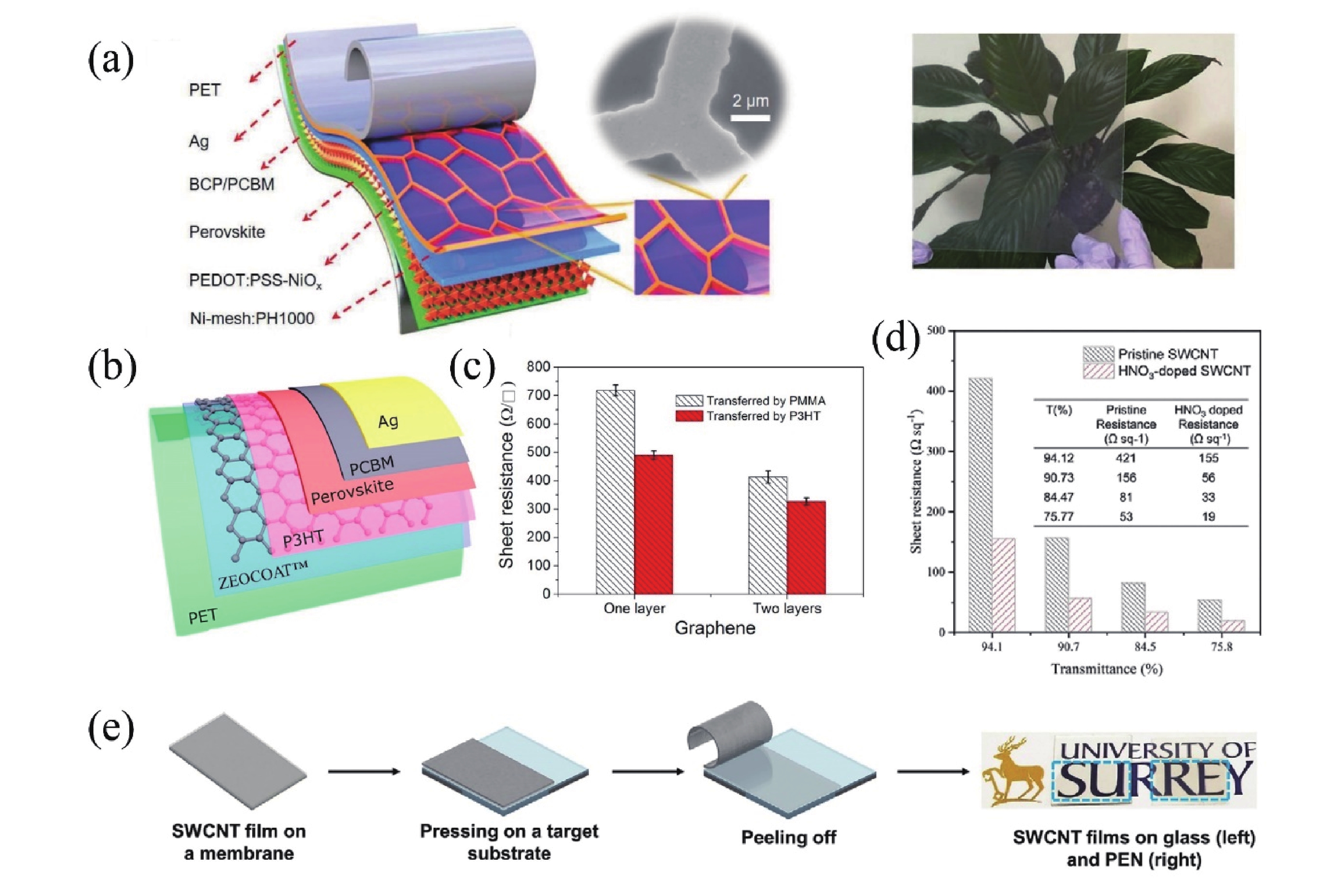
 DownLoad:
DownLoad:
